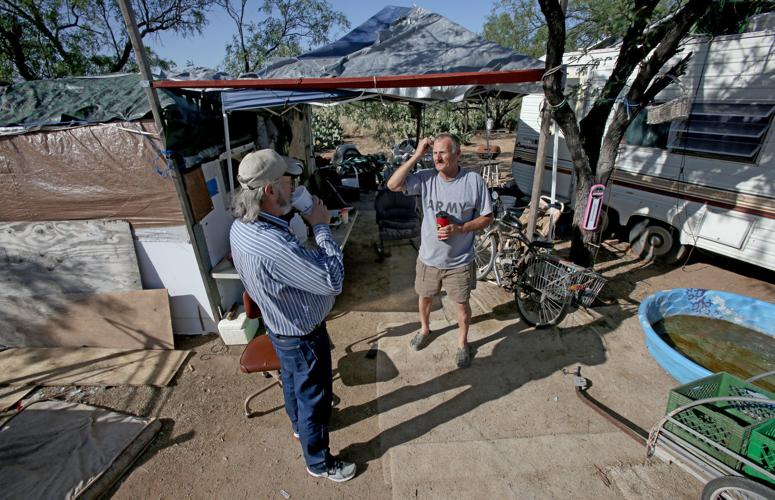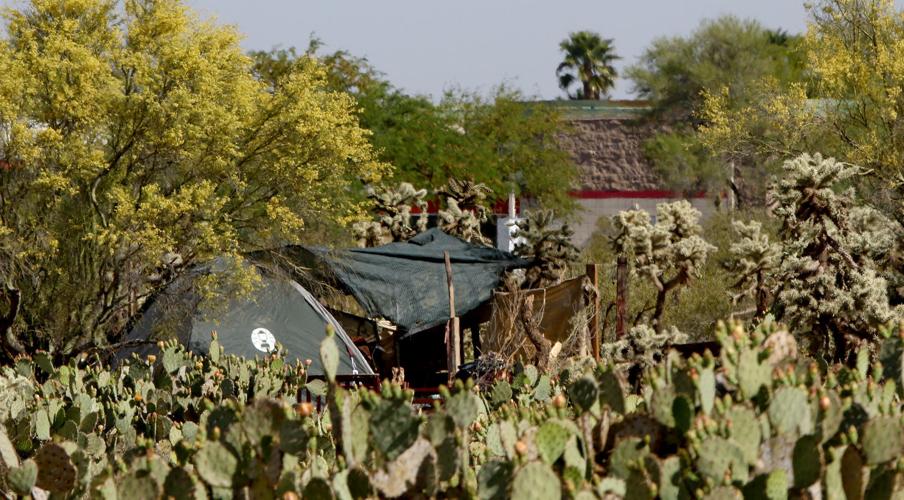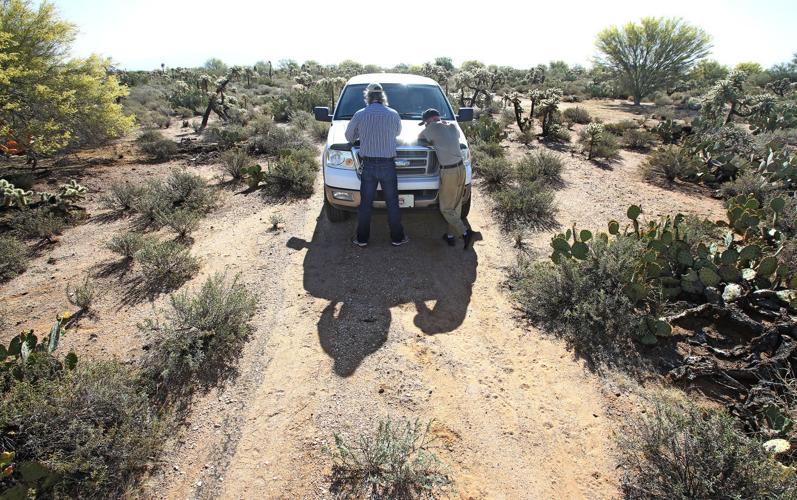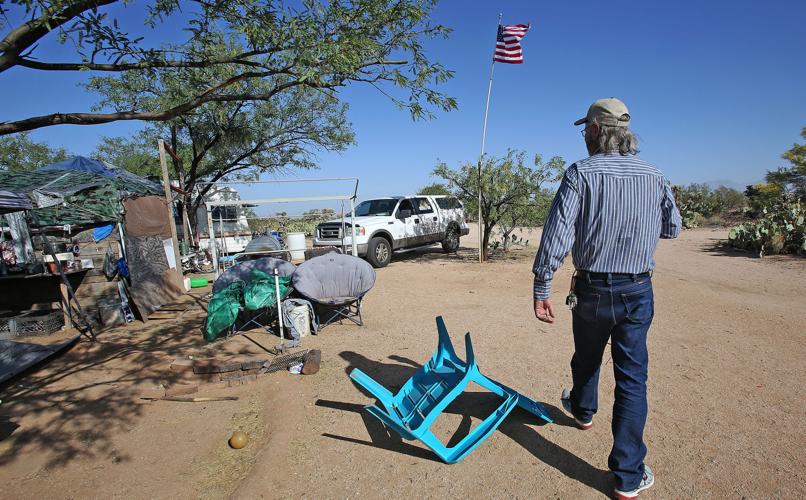After missing their original goal of ending veteran homelessness in Tucson by the end of 2015, community groups and local agencies have set a new target date: this summer.
Roughly 300 homeless veterans remain to be housed, according to Mayor Jonathan Rothschild’s office. The new goal, set for July 4, is to reach “functional zero,” which means there are fewer homeless veterans in a city than the city houses in a given month, according to Zero: 2016, a national initiative aiming to end veterans homelessness.
The agencies working to that end are still in the process of making changes to how they operate in order to achieve the city’s goal, said Karla Avalos, community organization and development director in the Mayor’s office.
“Trying to change what organizations and entities have done for decades is not easy to achieve overnight,” said Avalos, who focuses on ending veteran homeless. “But we’ve made remarkable progress in housing these veterans as we’ve learned these new processes.”
A partnership comprising community groups and local government agencies — including the city of Tucson, Pima County, Old Pueblo Community Services, the Primavera Foundation, the Southern Arizona VA Health Care System and the American Red Cross of Southern Arizona — has worked toward a goal of ending veteran homelessness in Tucson and Pima County since 2013. So far, the partnership, called the Tucson Pima Collaboration to End Homelessness, has managed to house more than 1,600 homeless veterans.
To achieve its goal, the agencies use the Homeless Management Information System, which tracks the homeless population in Tucson and Pima County.
Last year, it appeared on track for its target of reaching functional zero for veteran homelessness by the end of 2015.
The collaboration, however, misjudged how quickly it would be able to house the remaining veterans and how many veterans were still being added to its list, said Linda Kot, program manager for Project Action for Veterans at Primavera.
“We thought we had a better handle on our numbers than we actually did,” she said.
REMAINING VETERANS
When housing becomes available for veterans through Old Pueblo Community Services, outreach specialist Cliff Wade is responsible for going out in the field to find them. On a recent Tuesday morning, he set out in his truck through patches of desert in southeast Tucson.
Wade drove around to camps hidden in the brush looking for homeless veterans who might fill the 14 beds he has available. The first veteran he came across was Raye Parrish, who served in the Air Force.
“You ready to go in?” Wade asked in the small camp shaded by mesquite trees. “We have an opening.”
Parrish motioned to his trailer and his possessions. “I can’t lose all this stuff,” he said.
For homeless veterans, housing is not something they’re always eager to get into, said Jodi Frederick, homeless veteran outreach coordinator with the Tucson VA.
“For the homeless veterans who have been living in the desert for years and years, it’s often difficult for them to adjust to being housed,” she said. “It almost seems like the longer they’re out there, the harder it is for them to adjust.”
Wade drove to a few other camps, talking to both homeless veterans and nonveterans about their situations and options available for them.
One veteran signed paperwork for housing during the outing.
It’s not simply a matter of having beds available for them to sleep in, Wade said. Homeless vets have different needs based on their circumstances, he added, and they need to be matched with housing that will work for them.
“It’s one thing to get them into housing,” Wade said. “It’s another to get them into housing where they’ll be successful.”
BETTER COORDINATION
The agencies are working to better collaborate on homeless veterans through case conferencing, which involves agencies and community groups working together on individual cases to determine what housing and resources are called for to address their needs, Avalos said.
The system in place also prioritizes homeless veterans based on their vulnerability, which is determined through a questionnaire.
The agencies are also in the process of creating a comprehensive list with the names of all known homeless vets that will allow the groups to better track their housing status, Avalos said.
Among the challenges that still remain for the collaboration in getting the remaining veterans housed is the influx of those coming into Tucson from other places, said Wade, of Old Pueblo Community Services.
The warm weather in particular is a draw , Wade said.
“We’re getting them from West Texas, from Phoenix, from Prescott, from Oregon,” he said.
That makes it more difficult to track people coming in, Kot said.
There are more vets in need of housing than when the agencies first set out to end veteran homelessness three years ago.
“We’re always adding more names to our list as they come into the community, but we’re also getting them quickly housed,” Kot said.
NATIONAL INITIATIVES
Tucson is part of two national campaigns aimed at ending homelessness.
A campaign called 25 Cities seeks to end veteran homelessness in major American cities.
Zero: 2016 aims to end both veteran homelessness and chronic homelessness in 75 cities by the end of this year.
These campaigns came after the Obama administration launched the Mayors Challenge to End Veteran Homelessness, which is a collaboration of the VA, the Department of Housing and Urban Development and the U.S. Interagency Council on Homelessness, as well as cities and community groups around the country.
The national initiatives set forth at the national level have pushed cities to end homelessness in ways they hadn’t before, said Adam Gibbs, communications manager for Community Solutions, a New York-based group that manages the two campaigns.
“Before, it was really about managing the problem, and now it’s about finding a solution,” Gibbs said.
During 2015, about 30,000 homeless veterans and about 16,000 chronically homeless people were housed under the national initiatives.
The Obama administration originally called for ending veteran homelessness across the country by the end of 2015.
Gibbs said that goal helped get communities moving toward ending homelessness.
“We wouldn’t be where we are today if we hadn’t set that goal,” he said.
Twenty-three communities throughout the country and two states — Virginia and Connecticut — have reached the goal of ending that homelessness, according to HUD.
HOUSING OTHER HOMELESS
While Tucson has worked for the last three years to house its homeless veterans, the city also has its sights set on housing other homeless populations in the area.
The Tucson Pima Collaboration to End Homelessness has set a goal for housing chronically homeless people by the end of 2016.
About 285 remain, according to the last count completed, Avalos said.
In order for someone to meet that definition, the person must have a disability and have been homeless for at least a year or have been unable to hold down housing in the past few years.
“We’re going to take what we’ve learned with the veteran population and apply that to the chronically homeless, recognizing that the chronically homeless population is different,” Avalos said.
“They’re more vulnerable and have more expedient needs.”
Housing this population is different from the veteran population due to the availability of resources.
For example, many homeless veterans in Tucson could be housed through HUD’s Veterans Affairs Supportive Housing, or HUD-VASH, program. Chronically nonveteran homeless can’t access the program, Avalos said.
Many homeless vets could also receive treatment through the VA, which isn’t available to nonvets.
Some homeless veterans also don’t qualify for VA benefits.
In those cases, they would be referred to other agencies, said Frederick, of the Tucson VA.
Chronically homeless veterans would also need to be referred to local health-care providers through Cenpatico Integrated Care, the regional behavioral health authority for Southern Arizona.
Additionally, some of the housing programs that have been successful in housing homeless vets are funded only for veterans.
Old Pueblo, for example, can house up to 150 veterans in transitional housing and another 16 in Bridge housing, which serves veterans with more needs, said Nancy Jones, director of development at Old Pueblo.
These programs are funded through grants meant for homeless veterans.
The goal for the city is to house other remaining homeless populations, including family and youth homeless, by 2020, Avalos said.
“It is going to be an opportunity to see what our community offers and where we might be lacking,” she said.







